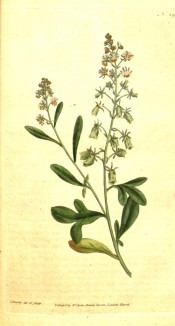Reseda odorata L.
Fully hardy, erect to slightly spreading perennial, usually grown as an annual, with loose, conical, raceme-like heads of tiny star-shaped, highly fragrant, yellowish-green or white to reddish-green flowers from summer to early autumn. To 60cm. The flowers have been prized for centuries for their fragrance, which lasts for months, even when cut and dried. It is still cultivated in France for the essential oils, which are used in perfumery. [RHSE, Hortus].
Horticultural & Botanical History
‘Mignonette grows naturally in Egypt, it was unknown to the older Botanists; Miller says, he received the seeds of it from Dr. Adrian Van Royen, Professor of Botany at Leyden, so that it is rather a modern inhabitant of our gardens. The luxury of the pleasure-garden is greatly heightened by the delightful odour which this plant diffuses; and as it is most readily cultivated in pots, its fragrance may be conveyed to the parlour of the recluse, or the chamber of the valetudinarian; its perfume, though not so refreshing perhaps as that of the Sweet-Briar, is not apt to offend on continuance the most delicate olfactories. Being an annual, it requires to be raised yearly from seed; when once introduced on a warm dry border, it will continue to sow itself, and grow very luxuriantly, flowering from June to the commencement of winter; but as it is desirable to have it as early as possible in the spring, the best way is either to sow the seed in pots in autumn, securing them through the winter in frames, or in a greenhouse, or to raise the seeds early on a gentle hot-bed, thinning the plants, if they require it, so as to have only two or three in a pot.’ [BM t.29/1787]. ‘It is only one age since this fragrant weed of Egypt first perfumed the European gardens, yet it has so far naturalised itself to our climate as to spring from seeds of its own scattering, and thus convey its delightful odour from the parterre of the prince to the most humble garden of the cottager. In less than another age we predict (without the aid of Egyptian art) that the children of our peasants will gather this luxurious little plant amongst the wild flowers of our hedge-rows.’ [Flora Historica quoted in FC p.222/1850]. It was certainly introduced to Britain from Italy by Miller as late as 1752, however it was believed to have been grown some 10 years earlier by Richard Bateman. [BR f.227/1817]. Such was the esteem in which Mignonette was held, seed was sold in bulk, at 4 shillings per pound. [Gard. Chron. 1849].
History at Camden Park
Listed in the 1845, 1850 and 1857 catalogues [H.206/1845].
Notes
Reseda odorata Gueldenst. ex Ledeb. (1841) = Reseda phyteuma L.
Published Feb 15, 2009 - 11:43 AM | Last updated Jul 30, 2010 - 04:51 PM
| Family | Resedaceae |
|---|---|
| Category | |
| Region of origin | North Africa |
| Synonyms | |
| Common Name | Common Mignonette |
| Name in the Camden Park Record | Reseda odorata |
| Confidence level | high |


